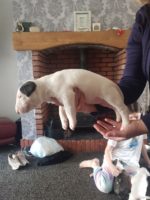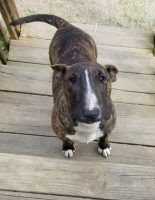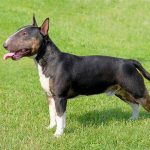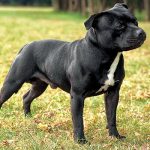 Other names for the Mini Bull Terrier are the Mini Bull, English Miniature Bull Terrier, or Miniature Bull Terrier. The breed is known for its courageous temperament and distinctive appearance. The dogs are bright, fiery, and amiable.
Other names for the Mini Bull Terrier are the Mini Bull, English Miniature Bull Terrier, or Miniature Bull Terrier. The breed is known for its courageous temperament and distinctive appearance. The dogs are bright, fiery, and amiable.
The Mini Bull Terrier descended from the now-extinct White English Terrier and the English Bulldog. Initially, the dogs were competitive gambling pit ratters. Later they became cherished family pets and watchdogs. The American Kennel Club recognized the Miniature Bull Terrier in 1963 in the Miscellaneous Class. In 1991, the breed received full approval as a Terrier Group member.
Appearance
The Bull Terrier has a neck that is muscular and long. Its chest is broad. The body is in square proportion. A muscular, back arches over the loin. The short tail is set low and carried horizontally. Two color varieties exist, colored and white. There may be markings on the head, but nowhere else, on the white type. Colored miniatures come in fawn, red, brindle, black-brindle, and tricolor. The flat, short coat is shiny and has a hard texture. A muscular body has skin pulled tightly over it.
Behavior
They have been known to cause lots of laughs as they tear through the yard or house for no apparent reason. Typically, the dogs are visitor-friendly, but they are excellent watchdogs and protect the family and home from those will ill intentions.
The Mini Bull Terrier needs a lot of exercise. Even though they are small in stature, they are hardy and happiest when active. Playing long games of fetch, short runs, or long walks daily provide their activity requirement. They let owners know if they lack needed exercise. Notoriously destruction behavior makes easy work of expensive furniture or flower beds.
Some develop neurotic behaviors. They chase their tails. Prolonged association with another unaltered male dog is intolerable for an intact Miniature Bull Terrier. Unpleasant confrontations take place that require permanent separation of the two makes.
Grooming
Frequent bathing is not necessary. A damp cloth or dry shampoo keeps the dogs smelling and looking fresh between baths. Check ears for signs of infection or redness weekly. Cleaning once each week with a cleaner approved by a veterinarian prevents harmful bacteria buildup. The teeth need brushing weekly also to prevent bad breath and keep gums and teeth healthy. Nails not worn down naturally, require clipping.
Health Issues
Training
Often, training is a long process. Fully trained dogs, test their boundaries as they grow older. Socialize puppies with children at an early age so the dogs accept the children as welcome guests.
 Originally bred in the 19th century for dog fighting, the Bull Terrier later became a fashion statement and a cherished companion of gentlemen. Nowadays, the Bull Terrier has gained acceptance as more of a family pet and in some cases, a show dog. Among the 340 dog breeds, of which the American Kennel Club only recognizes 167, the Bull Terrier remains one of the easiest to recognize because of his long and egg-shaped head. Bull Terriers can pack muscle on their frame much easier than some of the other dog breeds.
Originally bred in the 19th century for dog fighting, the Bull Terrier later became a fashion statement and a cherished companion of gentlemen. Nowadays, the Bull Terrier has gained acceptance as more of a family pet and in some cases, a show dog. Among the 340 dog breeds, of which the American Kennel Club only recognizes 167, the Bull Terrier remains one of the easiest to recognize because of his long and egg-shaped head. Bull Terriers can pack muscle on their frame much easier than some of the other dog breeds.







